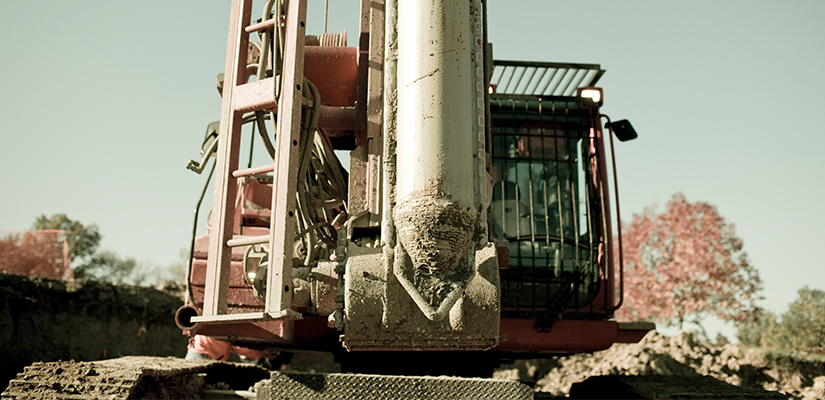A structure’s foundation is only as good as the ground it rests on, and it’s often the case that the ground needs improvement. Installing vibro stone columns —also known as aggregate piers— has fast become a preferred ground improvement method when soil can’t hold up a foundation on its own. Read on to learn how ground improvement contractors analyze a site’s soil properties to design treatments and determine installation methods.

As the cliché states, a structure’s most important component is its foundation. But a foundation won’t work if the ground it rests on is too weak to support it.
Installing vibro stone columns, also called aggregate piers, has quickly become a preferred ground improvement method because it often times dramatically strengthens weak soils at a lower cost than either building deep foundations or replacing weak soils with engineered fill.
Vibro stone columns or aggregate piers?
The terms are used interchangeably in the industry, but their origins differ slightly.
Aggregate piers is a generic term describing piers made of crushed stone that are installed across a building footprint under shallow foundation locations. Vibro stone columns are aggregate piers, but the term refers more specifically to the vibrating probes, or vibroflots, used to bore holes into the ground and then compact the columns of stone.
Although vibro ground improvement has been around for decades, only in the past several years have soil improvement contractors used vibrating probes to install aggregate piers. Their traditional use had been to compact granular soils.
This technique leads to additional cost savings because the costs of spoil removal and drill rig operation are eliminated. It can be substantially less expensive than the traditional rammed method of aggregate pier installation, which often requires pre-drilling.
Soil properties and design
A site’s soil properties have the potential to dramatically affect a structure’s design and cost of construction.
Design and pre-construction phases of projects include the careful study of the ground and the stresses a proposed structure would put on it. Variables include the bearing pressure exerted on the soil by a structure’s footings, the amount of post-construction settlement that’s acceptable and whether the soil in its current condition can handle those stresses.
When ground improvement is necessary, reports generated during this phase are reviewed by ground improvement contractors. It’s our job to design the appropriate ground improvement solution that will bring the soil up to the strength that the structure demands. For example, ground improvement contractors usually treat soil with aggregate piers to withstand bearing pressures in the range of 4,000 to 6,000 psf.
Sometimes, pre-treatment soil quality is good enough that the addition of aggregate piers will allow it to withstand up to 8,000 psf. Conversely, the poorer the quality of the soil, the lower the bearing pressure the soil will withstand even after treatment.
It’s also up to ground improvement contractors to be aware of the planned settlement of a structure when designing an aggregate pier treatment. The spread footings for most building structures have a required total settlement of one inch and a differential settlement of half an inch. However, some structures such as MSE walls, tanks and grain bins can sometimes settle a bit more without structural damage.
In rare cases, architects and engineers are sent back to the drawing boards when soil conditions are so poor that ground improvement becomes prohibitively costly.
At any rate, structural engineers must inform ground improvement contractors of bearing pressure and settlement criteria so that the most appropriate and cost-effective ground improvement treatments are developed. Likewise, ground improvement contractors can review borings in the geotechnical investigation phase to help determine reasonable recommendations for design bearing pressures using aggregate piers.
Soil properties and installation methodology
Vibro stone column installation techniques depend heavily on the properties of the soil in which the columns are installed. Ground improvement contractors must decide which of the following vibro stone column installation methods suits the circumstances:
- Dry top feed – This method is used in cohesive soils after the vibroflot creates the hole. Cohesive soil does not fall in on itself, so the vibroflot can be removed while aggregate is incrementally dumped into the hole. After each increment, the vibroflot is reinserted to compact the aggregate, gradually forming the pier.
- Dry bottom feed – This technique is used in relatively unstable soils, such as soft clay and silt below the water table. In this method, vibroflots are inserted and then kept in holes to prevent their collapse. A tremie is attached to the vibroflot to carry aggregate from a top-side hopper down to the bottom of the hole. The aggregate is then incrementally compacted.
- Wet top feed – Sandy, silty soils below the water table are prone to collapse. In this method, the vibroflot probes the hole and then remains inside. Water is jetted outward in all directions from the vibroflot, keeping the hole open as aggregate is gradually dumped in from the top. Incremental compaction follows.
Choose a trusted partner
Making sure the ground can support a structure is a team effort that requires equal parts communication and expertise among all parties involved. Subsurface Constructors has completed ground improvement at hundreds of sites across the U.S., building trusted relationships and a bank of knowledge unrivaled in the industry. See all we offer by viewing our services overview.
If you think your next project is a candidate for aggregate pier / vibro stone column ground improvement, request an aggregate pier applicability analysis that you can use to determine your next steps. You can also learn more about what we do by downloading our guide on aggregate pier ground improvement.


